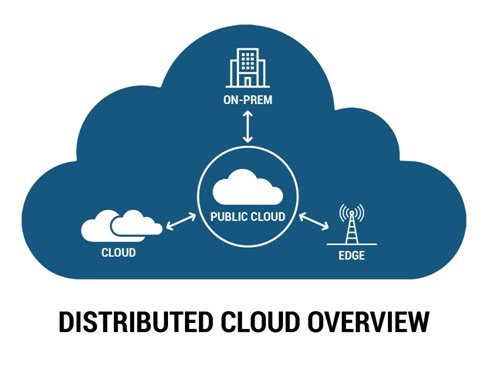Have you ever thought about how technology might change the way we use the cloud? In today’s fast-paced digital world, cloud computing has become an essential aspect of how I manage data, run applications, and conduct business. One exciting development in this field is distributed cloud technology. It brings with it a variety of benefits that can optimize my operations and improve the way I interact with my clients. Let’s unpack what distributed cloud technology is and explore its many advantages.
Understanding Distributed Cloud Technology
To begin, I think it’s important to understand what distributed cloud technology actually is. At its core, distributed cloud involves the distribution of cloud services and infrastructure across multiple locations. This approach can involve services running in various public clouds, private clouds, or even on-premise systems. This means that rather than relying on a single cloud provider and location, I can utilize multiple resources to meet my specific needs.
How Distributed Cloud Differs from Traditional Cloud Models
In a traditional cloud model, I often find that my data and applications are centralized in one physical location, usually managed by a single cloud service provider. On the other hand, with distributed cloud technology, I have the flexibility to select services from multiple providers, enhancing redundancy and reliability. For instance, if one cloud goes down, I can still access my data from another location.
Benefits of Resource Redundancy
This redundancy is crucial for business continuity. If I’m running a company, having my data spread out means that I can avoid significant downtime that could lead to lost revenue. Instead of putting all my eggs in one basket, I can distribute risk across different services.
Enhanced Performance and Latency
One of the standout benefits I’ve discovered about distributed cloud technology is improved performance. When I distribute my applications and data across multiple geographical locations, I can keep them closer to my users.
Minimizing Latency
Latency is the delay before transfer of data begins following an instruction. By placing my data and applications closer to my audience, I minimize latency. The faster the data transfer, the better the user experience. For example, if I run an e-commerce site, the last thing I want is for my page to load slowly. By utilizing a distributed cloud, I can improve loading times and keep my customers happy.
Real-world Examples
Several companies have already embraced this technology. Consider a global streaming service that delivers content to millions of users. By leveraging distributed cloud architectures, they can serve videos from data centers nearest to the users. This results in quicker loading times and fewer buffering issues.
Scalability and Flexibility
Another significant advantage of distributed cloud technology is its scalability and flexibility.
Adapting to Demand
In my business, demand can fluctuate dramatically. Sometimes, I might experience a surge in traffic due to a successful marketing campaign or a seasonal spike. Distributed cloud allows me to scale my resources up or down with ease. I can draw data storage and processing power from various locations without being constrained by the limits of a single provider.
Pay-as-you-go Model
Many distributed cloud services operate on a pay-as-you-go basis, which means I only pay for the resources I use. This cost-effective approach helps me manage my budget while ensuring I can scale my operations whenever necessary.
Data Sovereignty and Compliance
For many businesses, navigating data regulations can be a daunting task.
Meeting Local Compliance Requirements
With distributed cloud technology, I have the opportunity to store data in specific regions based on regulatory requirements. If I operate in multiple countries, this aspect is incredibly beneficial. I can ensure that I’m compliant with local laws without compromising on distributed infrastructure benefits.
Security Considerations
Moreover, the distributed nature of the cloud allows me to implement robust security measures tailored to specific jurisdictions. I can leverage various encryption techniques and access controls to protect sensitive data while ensuring that I adhere to local compliance mandates.
Improved Security Features
When it comes to security, distributed cloud technology offers innovative solutions to protect my data.
Multi-layered Security
The distributed architecture makes it harder for cyber threats to compromise my data. If an intruder targets one cloud service, the potential impact is reduced since my data isn’t at a single point of failure. Through the use of advanced firewalls, intrusion detection systems, and regular security audits, I can enhance my cloud’s security posture.
Data Encryption
Using distributed cloud technology also allows me to implement extensive encryption protocols. Even if data becomes intercepted or accessed by unauthorized users, encryption ensures that it remains unreadable and useless.
Cost Efficiency
Cost management is a critical component for any business, and I’ve found that distributed cloud technology can help me save money in several ways.
Reducing Infrastructure Costs
Traditionally, setting up the necessary infrastructure to support my operations could be prohibitively expensive. With distributed cloud technology, though, I can eliminate the need for extensive physical infrastructure. Instead, I can utilize cloud providers’ resources on an as-needed basis, reducing my overhead costs significantly.
Lower Maintenance Costs
Furthermore, maintenance becomes less of a burden. With a distributed model, I don’t have to worry as much about hardware upkeep and rapid obsolescence since the cloud providers take care of those details. I can direct my attention towards strategic business aspects instead.
Enhanced Collaboration and Innovation
Another area where distributed cloud technology shines is in fostering collaboration and innovation.
Breaking Down Silos
In any organization, breaking down silos is essential for innovation. By leveraging distributed cloud services, I can enable teams across different geographical locations to collaborate on projects in real-time. This facilitates larger contributions of ideas, feedback, and creativity, leading to better end products.
Integrated Tools for Collaboration
Many distributed cloud platforms come with integrated collaboration tools, which I find essential for keeping communication open and accessible. Features like shared workspaces, real-time document editing, and instant messaging improve the workflow within my team and streamline our processes.
Challenges That Come with Distributed Cloud Technology
While there are many benefits to distributed cloud technology, I must acknowledge that there are also some challenges I have to navigate.
Complexity of Management
One of the primary challenges I face is the complexity of managing multiple cloud services. Each provider may have its own set of tools and protocols. Managing these assorted platforms can become overwhelming without a solid strategy.
The Need for Skilled Personnel
Additionally, I often require my team to have specialized skills to manage this distributed infrastructure effectively. This can lead to potential training costs and a longer onboarding process for staff.
The Role of Hybrid Cloud in Distributed Cloud Technology
In my research, I have come across hybrid cloud models, which combine both public and private cloud services.
Blending Benefits
Utilizing a hybrid approach allows me to maintain control over sensitive data while leveraging the flexibility of public cloud services for less critical applications. I can strategically decide which services to run in the public cloud and which to secure with a private cloud.
Transitioning to Hybrid Solutions
Transitioning to a hybrid model can sound daunting, but I’ve found that many cloud providers offer tools and support to help simplify this process. This allows me to reap the benefits of both worlds without compromising on security or performance.
Future of Distributed Cloud Technology
As I look ahead, the future of distributed cloud technology seems bright. The industry is rapidly evolving, and new solutions are emerging that could enhance my experience even further.
The Rise of Edge Computing
One innovation worth discussing is the rise of edge computing, which complements distributed cloud technology beautifully. By processing data closer to where it’s generated rather than relying solely on central servers, I can expect even lower latency and improved application performance.
AI and Machine Learning Integration
Furthermore, I foresee the integration of AI and machine learning capabilities with distributed cloud models, leading to more intelligent resource management and enhanced decision-making processes. These technologies can help predict usage patterns and adjust resources accordingly, all while I sit back and benefit from the efficiency.
Choosing the Right Distributed Cloud Provider
With so many options available, selecting the right cloud provider for my distributed needs can feel overwhelming.
Evaluating Providers
I should look for key features such as reliability, scalability, data compliance, and security. I can also examine the support policies each provider offers to ensure that I always have access to help when I need it.
Real User Reviews
Another aspect I value is real user reviews. Hearing the experiences of others can give me an idea of what to expect. I appreciate this community feedback as it helps guide my decision-making process.
Conclusion
As I reflect on my journey with distributed cloud technology, I realize the transformative potential it holds for my operations. The benefits—ranging from enhanced performance to improved security and cost efficiency—paint an exciting picture for the future. While there are challenges to navigate, I believe the advantages far outweigh them.
I’m thrilled about the possibilities that lie ahead, and I look forward to leveraging distributed cloud technology to optimize my workflows, foster collaboration, and ultimately drive my business success.
In doing so, I feel empowered not only by the technology but also by the ever-changing landscape of digital solutions designed to meet my needs. The sky truly is the limit when it comes to what I can achieve with distributed cloud technology at my fingertips.






